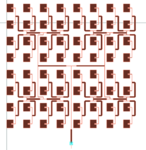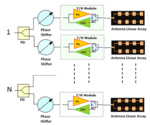Feed network for microwave applications is a major design concern in terms of complexity and size. There is various kind of feeding network of an array antenna. Feed network depend on antenna type and geometry.
Passive Antenna Array
(a) Corporate Feed Network : For a passive antenna, most popular feeding networks type is corporate feed network as shown below in fig. This technique integrates the RF feed network with the radiating elements on the same substrate. Due to a large number of the microstrip line in corporate feed, it’s lossy especially at high frequencies. Minimization of losses in the microstrip feed network may result in microstrip antenna arrays with high efficiency. The efficiency of microstrip antenna arrays may be improved by using a waveguide feed network. However, this results in a significantly increase in the antenna weight and dimensions. In this case, a transition from microstrip to the waveguide is required.
Corporate Feed Network

Another technique to minimize feed network loss is multi-layer configuration. Conductor loss may be minimized by designing the feed network length per wavelength as short as possible. By using a multi-layer feed network design, the feed network length per wavelength is minimized considerably. Corporate feed is also called parallel feed network, in this equal excitation can be achieved at the expense of compactness.
( b) Inline Series Feed Network : In a series-fed array the input signal, fed from one end of the feed network, is coupled serially to the antenna elements. The compact feed network of series-fed antenna arrays is one of the main advantages that make them more attractive than their parallel-fed counterparts. Beside compactness, the small size of series-fed arrays results in less insertion and radiation losses by the feed network Usually series fed arrays are more efficient than corporate fed arrays. However, corporate fed arrays have a well controlled aperture distribution. Series feed configurations suffer from narrow bandwidth and inherent phase difference caused by the differences in lengths of feed lines. Below is example of end-fed series feed network

Active Antenna Array
Active Phased arrays are usually composed of a feed network and a number of phase shifters. In Active phased-array antennae are antennae transmit power is produced by many TX/RX modules. In these antennas, each element is connected with separate transceiver module, so every radiating element got a small power amplifier in the antenna directly. Active antennae are usually phased array antennae. These antennas are primarily used in remote sensing satellite, adaptive antenna, 5G Beam forming antennas and Radars
Feed networks are used to distribute the output signal of the transmitter to the radiation elements and phase shifters control the phase of the signals at each radiating element to form a beam at the desired direction.

Feed Network for Shaped Beam pattern Arrays
Sometime special feed networks is design to obtained shaped antennas radiation pattern. Below is example of Cosec square shape beam pattern antenna feed network

Passive Antenna Array
(a) Corporate Feed Network : For a passive antenna, most popular feeding networks type is corporate feed network as shown below in fig. This technique integrates the RF feed network with the radiating elements on the same substrate. Due to a large number of the microstrip line in corporate feed, it’s lossy especially at high frequencies. Minimization of losses in the microstrip feed network may result in microstrip antenna arrays with high efficiency. The efficiency of microstrip antenna arrays may be improved by using a waveguide feed network. However, this results in a significantly increase in the antenna weight and dimensions. In this case, a transition from microstrip to the waveguide is required.
Corporate Feed Network
Another technique to minimize feed network loss is multi-layer configuration. Conductor loss may be minimized by designing the feed network length per wavelength as short as possible. By using a multi-layer feed network design, the feed network length per wavelength is minimized considerably. Corporate feed is also called parallel feed network, in this equal excitation can be achieved at the expense of compactness.
( b) Inline Series Feed Network : In a series-fed array the input signal, fed from one end of the feed network, is coupled serially to the antenna elements. The compact feed network of series-fed antenna arrays is one of the main advantages that make them more attractive than their parallel-fed counterparts. Beside compactness, the small size of series-fed arrays results in less insertion and radiation losses by the feed network Usually series fed arrays are more efficient than corporate fed arrays. However, corporate fed arrays have a well controlled aperture distribution. Series feed configurations suffer from narrow bandwidth and inherent phase difference caused by the differences in lengths of feed lines. Below is example of end-fed series feed network
Active Antenna Array
Active Phased arrays are usually composed of a feed network and a number of phase shifters. In Active phased-array antennae are antennae transmit power is produced by many TX/RX modules. In these antennas, each element is connected with separate transceiver module, so every radiating element got a small power amplifier in the antenna directly. Active antennae are usually phased array antennae. These antennas are primarily used in remote sensing satellite, adaptive antenna, 5G Beam forming antennas and Radars
Feed networks are used to distribute the output signal of the transmitter to the radiation elements and phase shifters control the phase of the signals at each radiating element to form a beam at the desired direction.
Feed Network for Shaped Beam pattern Arrays
Sometime special feed networks is design to obtained shaped antennas radiation pattern. Below is example of Cosec square shape beam pattern antenna feed network


